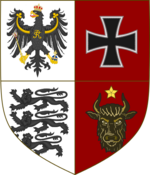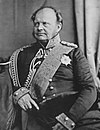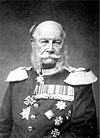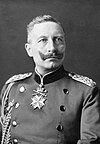House of Hechenreyt
This article is incomplete because it is pending further input from participants, or it is a work-in-progress by one author. Please comment on this article's talk page to share your input, comments and questions. Note: To contribute to this article, you may need to seek help from the author(s) of this page. |
| House of Hechenreyt Haus von Hechenreyt | |
|---|---|
 | |
| Country | |
| Founded | 1450 |
| Founder | Friedrich I of Hechenrhein |
| Current head | Disputed: HI&RH Frederick Augustus, Duke of Falkenhayn Disputed: HI&RH {Van-based pretender}, Duke of Wittenland Disputed: HI&RH Prince Louis Ferdinand, Duke of Rahdenburg |
| Final ruler | Heinrich III of Liothidia (1892-1918) |
| Titles | List
|
| Deposition | 1918: August Revolution |
| House of Rahdenburg |
|---|
The House of Hechenreyt, is an Ajaxi is a dynasty of former princes, electors, kings and emperors of Hechenrhein, Rahdenburg and the Liothidian Empire. The family arose in the area around the town of Hechenrhein in northern Rahdenburg during the 11th century and took their name from the Castle of the familial name. The first ancestor of the Hechenreyts was mentioned in 1061.
Over the centuries they would rapidly rise from the ruling family of the County of Rahdenburg, to the Duchy of Rahdenburg, which evolved in 1697 to become the Kingdom of Rahdenburg, and finally becoming the imperial family of the united Liothidia in 1826, following the Great Liothidian Revolution. They assumed the latter in wake of the Offer of the Crown from the Congress of Altersbach. They would govern Liothidia until 1918, becoming one of the most prominent royal households in Belisaria and respected.
Poor governance, stagnant politics and a poor economy between 1890 and 1918 would dramatically undermine the dynasty's position within Liothidia. These failings and a well-organised socialist movement would eventually lead to the August Revolution (1917-18) and the establishment of the Liothidian Democratic People's Republic, and thus the overthrow of the Liothidian monarchy. Just under half of the ruling Hechenreyt family would be killed or imprisoned during the revolution and the loss of virtually all of their assets and estates in the country. Owing to the loss of numerous family figures, the current head of the family and dynasty is disputed between Latin-based Prince Louis Ferdinand, Duke of Rahdenburg; Lyncanestrian-based Frederick Augustus, Duke of Falkenhayn; and the Vannois-based Joseph, Duke of Wittenland.
Origins and history
County of Hechenrhein
Hechenrhein was a county of the Duchy of Wittenland. Its ruling dynasty was first mentioned in 1061. The Hechenreyts named their estates after Hechenreyt Castle-town until the name later evolved into its current form. Later its capital was moved to the fortress of Löwenkopf. The Löwenkopf and Hechenrhein castles were destroyed in the immediate aftermath of the August Revolution.
According to the medieval chronicler Viktor of Hauchen, Friedrich I, Count of Hechenrhein (de Hechenrhein) was born before 1405 and died in 1452. The Hechenrheins received the comital title from Duke Georg III. As loyal vassals of the Wittenlander Falkynstein dynasty, they were able to significantly enlarge their territory. The family would continue to remain loyal and steadfast vassals to the numerous Falkynstein Dukes they saw continued expansion of their territory, wealth and influence.
In 1653 tensions arose between the Hechenreyts and the Wittenlander Falkynstein dynasty, especially over the latter's refusal to submit to the Unified Liothidian Realm. Through their position as a major family of merchants, the Hechenreyts had established strong ties with the Holzherr dynasty in growing united Liothidian kingdom based around Rahdenburg, as such they had moved to pressure the Wittenlander Duke into submitting to the Liothidian King. Count Gottfried I saw a great success in the marriage of his daughter Katerina to Prince Burkhard II, the heir to the Kingdom's throne. This move by a county-level family enraged the Duke of Wittenland, who convened his entire family to the family's castle at Schwarzberg on April 19 1654. That night, a fire broke out, eventually spreading across the entire complex. In the space of one night, the entire Falkynstein family was killed. On April 20, King Konrad III awarded the Duchy of Wittenland to the Hechenreyts, raising Gottfried to Duke. The sudden death and elevation of the family soon resulted in accusations that the Hechenreyts were responsible for the fire.
Counts of Hechenrhein (1450–1654)
- Friedrich I (until 1451)
- Friedrich II (1451-1460)
- Georg the Wise (1460-1488)
- Georg II (1488-1498)
- Konrad I (1498-1515)
- Konrad II (1515-1521)
- Friedrich III (1521-1540)
- Georg III (1540-1567)
- Georg IV (1567-1573)
- Friedrich IV (1573-1584)
- John I (1584-1601)
- John II (1601-1619)
- John III (1619-1625)
- Konrad III (1625-1641)
- Friedrich V (1641-1649)
- Gottfried I (1649-1653: elevated to Duke of Wittenland)
Duchy of Rahdenburg (1654-1697)
In 1654, the Hechenreyts secured acceptance from the Great Council of the Liothidian Realms to elevate Rahdenburg from a county to a Duchy. This breakthrough came as a result of the County's prominent role in the War of the Barons, in which they successfully aided the Liothidian Realms crush a revolt led by the upstart Baron Reinhardt von Holstein. The elevation resulted in a dramatic improvement to the family's holdings, power and influence as they swiftly moved to secure lasting domination of the Boreios Trade Routes. In 1660, Rahdenburg was dramatically expanded with the conquest of the nascent Koscian Duchy of Nowogard, this further granted the Hechenreyt family and their Duchy access to resources such as ore, timber and fertile farmland, which they used to combat the near-perpetual poverty that gripped the region for over a century.
By 1680, the Duchy of Rahdenburg through control of the Boreios trade routes had become the wealthiest of the Liothidian states in the north, much to the chagrin of many states within the Liothidian Realms. Between 1680 and 1684, tensions began to arise on the Great Council, as numerous electors plotted to pursue ways of diminishing Rahdenburg's wealth and influence, in turn Rahdenburg aligned with the Duchies of Rüdesheim, Südsachsen and Wittenland against Dannenburg and Nordenland. This period saw a series of skirmishes between the two-sides which essentially split the Realms in two, between east and west respectively. This escalated dramatically in 1686, with the Battle of Drassen Forest, between Rahdener and Nordenic armies. Count Konrad VII of Rahdenburg secured a resounding victory, however, rather than punish Nordenland for its conspiracy against the Hechenreyt dynasty, he opted for the status-quo, albeit with a dramatic tipping of the balance of power on the Great Council toward Rahdenburg and its allies.
From 1686 until 1697, the Hechenreyts used this new found dominance within the Realms to pursue lucrative trade and business links with other Belisarian kingdoms and states, nominally on behalf of all Liothidian Realms, but more often than not, these new links were directed through Rahdenburg's allies to the south and east to itself, further altering the balance of power and influence toward its bloc. In the process, the family itself became immensely wealthy, funding the construction of lavish public and private buildings, as well as offering lavish gifts to the Fabrian Catholic Church.
Massacre of Cölln
In 1696, the prominent port-city of Cölln in northern Rahdenburg saw its popular Lord Mayor, Georg von Cölln pass away. His family, a subordinate noble family within the Hechenreyt court struggled to find a suitable successor, owing to his lack of an heir and his immediate male relatives being in the clergy or of unsound character. Sensing an opportunity, Count Friedrich August II, appointed his cousin, Charles Paul as Lord Mayor. The local population, rejected him, opting for any relative of the Von Cölln family. In response to this slight, Count Friedrich August II amassed his army and marched on Cölln. Though he originally sought to use his army as mere pressure for the locals to accept his appointment, the city fortified itself and its citizens armed themselves in opposition.
On April 4 1696, furious at the rejection of his authority, Count Friedrich August besieged Cölln. Unable to resist the Count's army, the city fell and in within hours, the Count's army had slaughtered the entire population of an estimated 6,500 people and burnt the city to the ground, while protecting the port. The massacre had a profound effect on the trajectory of the Hechenreyt family's rise, while it sent shockwaves across Belisaria. Many of the other states of the Liothidian Realms bulked at the violence and bloodshed, with many of the Electors fearing for their own cities and towns in the event of a Hechenreyt outrage, this would only further subordinate the Great Council to the Hechenreyt dynasty, which would become vital in 1697, with the deeply controversial and much debated 'Congress of 97' in which the Great Elector Council vote to elevate Rahdenburg to that of Kingdom.
Kingdom of Rahdenburg (1697-1826)
In 1697, Count Friedrich August II died and was succeeded by his deeply ambitious son, Friedrich III. He took up his father's work, in the effort to secure the elevation of Rahdenburg to that of a Kingdom. Aided by his mother, wife and brothers, they traveled across southern Liothidia, to essentially "charm the votes in their favour", while his father's role in the Massacre of Cölln had essentially secured the backing of the smaller elector-states in any pursuit. By November of 1697, the only states to oppose the elevation of Rahdenburg were Dannenburg and Nordenland, however, in a move of political savvy, Count Friedrich III promised the Von Hohenstein family of Nordenland, support for its elevation to a Kingdom, while Friedrich also promised his second daughter, Teresa Viktoria to Duke Sigmar Michael II of Nordenland's eldest son. Nordenland agreed and in early December, the Great Council of the Liothidian Realms convened in Karschau and backed the elevation of Rahdenburg. On Christmas Day, Count Friedrich III was crowned King Friedrich I of Rahdenburg.
His deal with Nordenland secured the now term, Great Balance of the Realms, which equalised Rahdenburg with Nordenland. With the two-rivals now equal in status and interlinked by personal marriage, the Liothidian Realms enjoyed a period of internal peace and stability that would last until 1810, during this period Liothidian culture, science, theology and military prowess expanded dramatically. Externally, the Realms would fight numerous conflicts against its neighbours, including the total conquest of Koscia in 1719, led by King Friedrich I, as well as numerous conflicts with Vannois over fertile border regions and periodic clashes with the Riet kingdoms to the west.
In 1735, Friedrich I was succeeded by his son Friedrich II who took dramatic efforts within the Kingdom of Rahdenburg as well as the Realms to combat further arrivals of Protestanism and Albanism. In Koscia, these efforts often included the mass destruction of villages and holdouts of reformist and protestant communities. In 1740, Friedrich II led the Realms in the Second Northern War against Levenkusen, which resulted in its subordination to the Realms and the decimation of its protestant elites. Under Friedrich II, science and the arts flourished as he offered lucrative patronage to numerous great minds of the time, during his reign, the city of Rahden was dramatically improved, with paved roads, brick buildings and a new university.
Continued rise
Great Liothidian Revolution
Liothidian Empire (1846-1918)
Liothidian Revolution
Fall from power
Post-revolution
List of Hechenreyt monarchs (1846-1918)
| Portrait | Name | From | Until | Relationship with predecessor |
|---|---|---|---|---|

|
August-Wilhelm I | 10 May 1846 | 12 December 1858 | First monarch of the united Kingdom of Liothidia |

|
Heinrich I | 12 December 1858 | 9 June 1885 | Brother of August-Wilhelm I |

|
Heinrich II | 9 June 1885 | 5 January 1890 | Son of Heinrich I |

|
Heinrich III | 5 January 1890 | 10 August 1918 | Son of Heinrich II |




